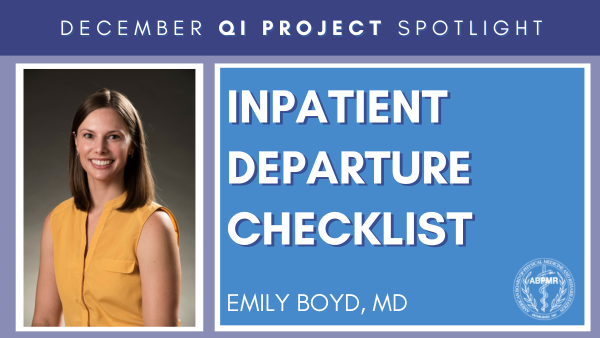CC
QI Spotlight: Inpatient Departure Checklist

The December QI Project Spotlight was submitted by Emily Boyd, MD.
Dr. Boyd has been a board-certified physiatrist for six years. She graduated from The University of Queensland/Ochsner Clinical School in 2012 and completed her PM&R residency at Emory University. She is currently the medical director at Piedmont Eastside Inpatient Rehabilitation in Snellville, GA
In her practice, Dr. Boyd wanted to implement a strategic process improvement by incorporating detailed case management (CM) reporting during bedside team conference in an effort to facilitate communication, and therefore, improve accuracy and efficiency of durable medical equipment (DME) ordering/delivery.
Thank you for submitting your project, Dr. Boyle!
The QI Project Spotlight is a periodic feature on the ABPMR News Center to highlight exemplary Quality Improvement projects submitted by your fellow diplomates (or residents) for continuing certification (CC) credit. Diplomates can use the QI Project Spotlight as a tool to plan their own QIs or as a way to connect with other diplomates doing similar work.

What is the problem you are trying to solve?
Untimely recommendations for discharge DME (durable medical equipment) upon departure from IPAR (Inpatient Acute Rehab), resulting in incorrect equipment being ordered and delivered to patients, subsequently delaying discharge process and potentially creating a situation where patient transitions home with insufficient adaptive equipment / assistive devices (contributing to safety concerns).
What data (objective measurements) do you have that supports this as a problem?
Cursory retroactive chart audit/review in partnership with CM (Case Management) over a 3-month period revealed that, on average, patient's DME orders on discharge from IPAR were incomplete/inaccurate within 72 hours of anticipated discharge date, at an approximate rate nearing 40%.
What is your opportunity statement? State the goal you hope to achieve.
Implement strategic process improvement by incorporating detailed CM reporting during bedside team conference (re: projected discharge equipment / updated recommendations) in an effort to facilitate communication, and hence, improve accuracy and efficiency of DME ordering/delivery. Concurrent aim of achieving enhanced patient safety as well as satisfaction with discharge planning procedure. Goal of placing complete and accurate DME order within three days of discharge >75% of time; should be realistic to accomplish this goal within a 30-day period.
What is the underlying cause of the performance/quality problem?
Lack of effective and updated/timely closed-loop communication amongst interdisciplinary team members.

What change(s) did you implement?
Process change to ensure consistent/structured weekly team conference reporting at patient bedside, solidifying a formal slot for CM to report out on projected DME needs upon discharge. As the physician leader of team conference, I directed CM reports to follow Nursing and Therapy disciplines. Bedside reporting simultaneously allows patients/families an opportunity for questions to be answered by treatment team in real-time. Therapists also incorporated process change of notating updates to equipment recommendations within documentation to reflect accurate orders within 3 days of patient discharge, as well as sending secure chat message to CM if there are updates within 48-hour window leading up to planned departure.

Did you achieve your goal or target from your opportunity statement? What data do you have to support your conclusion?
Yes. Data collected on excel spreadsheet tracking any late (<48 hour) adjustments to recommended DME. Over a month-long period following implementation, data-tracking demonstrates improved accuracy of equipment ordering, with >80% (82.8%) of patients receiving equipment timely and without need for order adjustment within previously designated 'late' timeframe.

How will you maintain the success of your project going forward?
Maintain consistency with conference reporting structure to promote closed-loop communication amongst all team members present. Continue to reinforce importance of accurate and timely projections of DME needs upon discharge, as well as prompt notification whenever updated recommendations are made.



